A Dual-Inlet Pump with a Simple Valves System
Abstract
:1. Introduction
2. Design and Operating Principle
2.1. Construction of the Pump
2.2. Working Principle of the Pump
- Step 1.
- Voltage excitation is applied to the surface of the piezoelectric actuator to make it bend and vibrate under the action of an external electric field. When the piezoelectric actuator bends upward, the volume of the pump chamber increases and the internal pressure decreases. Once the external pressure is greater than the opening pressure of the inlet valves, the inlet valves open and the outlet valve closes. Then, the liquid is absorbed into the pump.
- Step 2.
- After bending up to the extreme point, the piezoelectric actuator gradually returns to the equilibrium state. The fluid pressure is balanced with the external pressure at this time, and the inlet and outlet valves are closed. Then, the liquid is retained in the pump.
- Step 3.
- Next, the piezoelectric actuator bends downwards, the volume of the pump chamber decreases, and the liquid pressure increases. Once the liquid pressure is greater than the opening pressure of the outlet valve, the outlet valve opens and the inlet valves close. Then, the liquid is discharged from the pump.
2.3. Theoretical Analysis of the Pump
3. Simulation and Verification
3.1. Fabrication Process
3.2. Finite Element Analysis of the Piezoelectric Actuator
3.3. Test of Vibration Characteristics
4. Experiments and Summaries
4.1. Experimental Conditions
4.2. Working Frequency of the Prototype
4.3. Valve Stiffness
4.4. Chamber Height
4.5. Viscosity of Fluid
5. Conclusions
- (1)
- In accordance with the finite element simulation results of the piezoelectric actuator under dry and wet modes, the amplitude frequency response characteristics displayed through laser scanning tests were analyzed. The first-order out-of-plane stretching vibration mode in the low frequency range confirmed the working mode of the pump; thus, the preliminary operating frequency was mastered.
- (2)
- By adjusting the physical characteristics of the cantilever valves and the structural parameter of the pump chamber, the improvement of the output flow performance was feasible. Reducing the stiffness of the valve helped to make its opening and closing responses better, and the liquid flowing through the pump chamber became more concentrated with a lower height.
- (3)
- The proposed piezoelectric pump prototype has a compact and simple configuration of a Φ 48 mm × 22 mm external size, with a maximum flow rate of 33.18 mL/min under a 180 Vp-p voltage at a driving frequency of 100 Hz. It may have potential application in places of microfluidics operation, such as liquid medicine transportation and agricultural drip irrigation.
Author Contributions
Funding
Data Availability Statement
Acknowledgments
Conflicts of Interest
References
- Ren, Y.; Ma, Y.; Huang, D.; Chen, J.; Feng, Z. Elastic string check valves can efficiently heighten the piezoelectric pump’s working frequency. Sens. Actuators A Phys. 2016, 244, 126–132. [Google Scholar]
- Deng, J.; Liu, Y.; Liu, J.; Xu, D.; Wang, Y. Development of a planar piezoelectric actuator using bending-bending hybrid transducers. IEEE Trans. Ind. Electron. 2019, 66, 6141–6149. [Google Scholar]
- Li, Y.; Le, Y.; Goo, N.S.; Kim, T.H.; Lee, C.S. High actuation force of piezoelectric hybrid actuator with multiple piezoelectric pump design. J. Intell. Mater. Syst. Struct. 2017, 28, 2557–2571. [Google Scholar]
- Li, W.; Li, D.; He, L.; Wang, Y.; Wang, D.; Qiao, L. A review of recent studies on valve-less piezoelectric pumps. Rev. Sci. Instrum. 2023, 94, 031502. [Google Scholar]
- Hu, R.; He, L.; Hu, D.; Hou, Y.; Cheng, G. Recent studies on the application of piezoelectric pump in different fields. Microsyst. Technol. 2023, 29, 663–682. [Google Scholar]
- Glynne-Jones, P.; Coletti, M.; White, N.M.; Gabriel, S.B.; Bramanti, C. A feasibility study on using inkjet technology, micropumps, and MEMs as fuel injectors for bipropellant rocket engines. Acta Astronaut. 2010, 67, 194–203. [Google Scholar]
- Li, H.; Liu, J.; Li, K.; Liu, Y. A review of recent studies on piezoelectric pumps and their applications. Mech. Syst. Signal Pract. 2021, 151, 107393. [Google Scholar]
- Hu, B.; Yu, H. Optimal design and simulation of a microsuction cup integrated with a valveless piezoelectric pump for robotics. Shock. Vib. 2018, 2018, 7987502. [Google Scholar]
- Hwang, J.-H.; Bae, J.-S.; Hwang, Y.-H.; Kwon, J.-Y. Pressurization characteristics of a piezoelectric-hydraulic pump for UAV brake systems. Int. J. Aeronaut. Space Sci. 2018, 19, 776–784. [Google Scholar]
- Yan, Q.; You, J.; Sun, W.; Wang, Y.; Wang, H.; Zhang, L. Advances in piezoelectric jet and atomization devices. Appl. Sci. 2021, 11, 5093. [Google Scholar]
- Kim, G.W.; Wang, K.W. Enhanced control performance of a piezoelectric—Hydraulic pump actuator for automotive transmission shift control. Proc. Inst. Mech. Eng. Part D J. Automob. Eng. 2009, 224, 161–174. [Google Scholar]
- Zhang, J.; Leng, X.; Zhao, C. A spiral-tube-type valveless piezoelectric pump with gyroscopic effect. Sci. Bull. 2014, 59, 1885–1889. [Google Scholar]
- Luo, W.; Chen, R.; Ma, H. Concept of the partial throw-away design of piezoelectric micropump for medical uses with low cost and waste. Appl. Mech. Mater. 2013, 477–478, 363–367. [Google Scholar]
- Jenke, C.; Rubio, J.P.; Kibler, S.; Haefner, J.; Richter, M.; Kutter, C. The combination of micro diaphragm pumps and flow sensors for single stroke based liquid flow control. Sensors 2017, 17, 755. [Google Scholar]
- Opekar, F.; Nesmerak, K.; Tuma, P. Electrokinetic injection of samples into a short electrophoretic capillary controlled by piezoelectric micropumps. Electrophoresis 2016, 37, 595–600. [Google Scholar]
- Yan, Q.; Yin, Y.; Sun, W.; Fu, J. Advances in valveless piezoelectric pumps. Appl. Sci. 2021, 11, 7061. [Google Scholar]
- Hou, Y.; He, L.; Zhang, Z.; Yu, B.; Jiang, H.; Cheng, G. The characters exploration of a piezoelectric pump with fishtail-shaped bluffbody. J. Intell. Mater. Syst. Struct. 2021, 33, 972–984. [Google Scholar]
- Zhang, B.; Huang, Y.; He, L.; Xu, Q.; Cheng, G. Research on double-outlet valveless piezoelectric pump with fluid guiding body. Sens. Actuators A Phys. 2020, 302, 111785. [Google Scholar]
- Yang, S.; He, X.; Yuan, S.; Zhang, X.; Zhu, J.; Yan, J. A bidirectional valveless piezoelectric micropump with double chambers based on Coanda effect. J. Braz. Soc. Mech. Sci. 2016, 38, 345–353. [Google Scholar]
- He, X.; Bian, R.; Lin, N.; Xu, W.; Deng, Z.; Yang, S. A novel valveless piezoelectric micropump with a bluff-body based on Coanda effect. Microsyst. Technol. 2019, 25, 2637–2647. [Google Scholar]
- Bao, Q.; Zhang, J.; Tang, M.; Huang, Z.; Lai, L.; Huang, J.; Wu, C. A novel PZT pump with built-in compliant structures. Sensors 2019, 19, 1301. [Google Scholar] [CrossRef]
- Yan, Q.; Yin, Y.; Wang, L.; Wang, H.; Sun, W. Theoretical and experimental research on valve-less piezoelectric pump with arc-shaped tubes. Rev. Sci. Instrum. 2022, 93, 105004. [Google Scholar] [CrossRef] [PubMed]
- He, L.; Wu, X.; Zhang, Z.; Wang, Z.; Zhang, B.; Cheng, G. Experiment analysis of high output pressure piezoelectric pump with straight arm wheeled check valve. J. Intell. Mater. Syst. Struct. 2021, 32, 1987–1996. [Google Scholar] [CrossRef]
- Wang, J.; Zhao, X.; Chen, X.; Yang, H. A piezoelectric resonance pump based on a flexible support. Micromachines 2019, 10, 169. [Google Scholar] [CrossRef]
- Cheng, C.-H.; Tseng, Y.-P. Characteristic studies of the piezoelectrically actuated micropump with check valve Microsystem Technologies-Micro-and Nanosystems-Information Storage and Processing Systems. Microsyst. Technol. 2013, 19, 1707–1715. [Google Scholar] [CrossRef]
- Zhang, Z.; Kan, J.; Wang, S.; Wang, H.; Ma, J.; Jiang, Y. Effects of driving mode on the performance of multiple-chamber piezoelectric pumps with multiple actuators. China J. Mech. Eng. 2015, 28, 954–963. [Google Scholar] [CrossRef]
- He, L.; Wu, X.; Zhao, D.; Li, W.; Cheng, G.; Chen, S. Exploration on relationship between flow rate and sound pressure level of piezoelectric pump. Microsyst. Technol. 2019, 26, 609–616. [Google Scholar] [CrossRef]
- Peng, T.; Guo, Q.; Yang, J.; Xiao, J.; Wang, H.; Lou, Y.; Liang, X. A high-flow, self-filling piezoelectric pump driven by hybrid connected multiple chambers with umbrella-shaped valves. Sens. Actuators B Chem. 2019, 301, 126961. [Google Scholar] [CrossRef]
- Chen, S.; Qian, C.; Cheng, W.; Kan, J.; Ji, J.; Zhang, Z.; Wang, J. A low frequency driven piezoelectric pump with flexible valve. Sens. Actuators A Phys. 2021, 319, 112567. [Google Scholar] [CrossRef]
- Huang, J.; Zhu, Y.; Shi, W.; Zhang, J. Theory and experimental verification on cymbal-shaped slotted valve piezoelectric pump. Chin. J. Mech. Eng. 2018, 31, 2. [Google Scholar] [CrossRef]
- Zhou, J.; Sun, W.; Fu, J.; Liu, H.; Wang, H.; Yan, Q. Working mechanisms and experimental research of piezoelectric pump with a cardiac valve-like structure. Micromachines 2022, 13, 1621. [Google Scholar] [CrossRef]
- Huang, W.; Lai, L.; Chen, Z.; Chen, X.; Huang, Z.; Dai, J.; Zhang, F.; Zhang, J. Research on a piezoelectric pump with flexible valves. Appl. Sci. 2021, 11, 2909. [Google Scholar] [CrossRef]
- Wu, X.; He, L.; Hou, Y.; Tian, X.; Zhao, X. Advances in passive check valve piezoelectric pumps. Sens. Actuators A Phys. 2021, 323, 112647. [Google Scholar] [CrossRef]
- Yang, X.; Zhou, Z.; Cho, H.; Luo, X. Study on a PZT-actuated diaphragm pump for air supply for micro fuel cells. Sens. Actuators A Phys. 2006, 130–131, 531–536. [Google Scholar] [CrossRef]
- Ye, Y.; Chen, J.; Pan, Q.S.; Feng, Z.H. Suppressing the generation of cavitation by increasing the number of inlet check valves in piezoelectric pumps. Sens. Actuators A Phys. 2019, 293, 56–61. [Google Scholar] [CrossRef]
- Kan, J.; Yang, Z.; Peng, T.; Cheng, G.; Wu, B. Design and test of a high-performance piezoelectric micropump for drug delivery. Sens. Actuators A Phys. 2005, 121, 156–161. [Google Scholar]
- Ma, H.-K.; Hou, B.-R.; Wu, H.-Y.; Lin, C.Y.; Gao, J.J.; Kou, M.C. Development and application of a diaphragm micro-pump with piezoelectric device. Microsyst. Technol. 2007, 14, 1001–1007. [Google Scholar] [CrossRef]
- Ma, H.-K.; Hou, B.-R.; Wu, H.-Y.; Lin, C.Y.; Gao, J.J. The improved performance of one-side actuating diaphragm micropump for a liquid cooling system. Int. Commun. Heat Mass Transf. 2008, 35, 957–966. [Google Scholar] [CrossRef]
- Woo, J.; Sohn, D.K.; Ko, H.S. Performance and flow analysis of small piezo pump. Sens. Actuators A Phys. 2020, 301, 111766. [Google Scholar] [CrossRef]
- Liu, X.; Li, X.; Wang, M.; Cao, S.; Wang, X.; Liu, G. A high-performance piezoelectric micropump with multi-chamber in series. Appl. Sci. 2022, 12, 4483. [Google Scholar] [CrossRef]
- Yang, Z.; Dong, L.; Wang, M.; Li, X.; Liu, X.; Liu, G. A miniature piezoelectric pump with high performance. AIP Adv. 2022, 12, 065316. [Google Scholar] [CrossRef]
- Park, J.H.; Seo, M.Y.; Ham, Y.B.; Yun, S.N.; Kim, D.I. A study on high-output piezoelectric micropumps for application in DMFC. J. Electroceram. 2012, 30, 102–107. [Google Scholar] [CrossRef]
- He, L.; Hou, Y.; Hu, D.; Hu, R.; Zhang, Z.; Cheng, G. Research on a large opening and high flow rate piezoelectric pump with straight arm wheeled check valve. Rev. Sci. Instrum. 2022, 93, 035002. [Google Scholar] [CrossRef] [PubMed]
- Li, H.; Liu, J.; Li, K.; Deng, J.; Liu, Y. Development of a High-Pressure Self-Priming Valve-Based Piezoelectric Pump Using Bending Transducers. IEEE Trans. Ind. Electron. 2021, 69, 2759–2768. [Google Scholar] [CrossRef]
- Liu, Y.; Yan, J.; Wang, L.; Chen, W. A two-DOF ultrasonic motor using a longitudinal-bending hybrid sandwich transducer. IEEE Trans. Ind. Electron. 2019, 66, 3041–3050. [Google Scholar] [CrossRef]
- Shi, M.X.; Liu, B.; Zhang, Z.Q.; Zhang, Y.W.; Gao, H.J. Direct influence of residual stress on the bending stiffness of cantilever beams. Proc. R. Soc. A Math. Phys. Eng. Sci. 2012, 468, 2595–2613. [Google Scholar] [CrossRef]
- Fan, Z.; Liu, J.; Dong, J.; Li, J.; Yang, Z. Study on the performance of piezoelectric pump for viscous liquid pumping. In Proceedings of the 2009 National Symposium on Piezoelectric and Acoustic Theory and Device Technology, Wuhan, China, 17–20 December 2009. [Google Scholar]

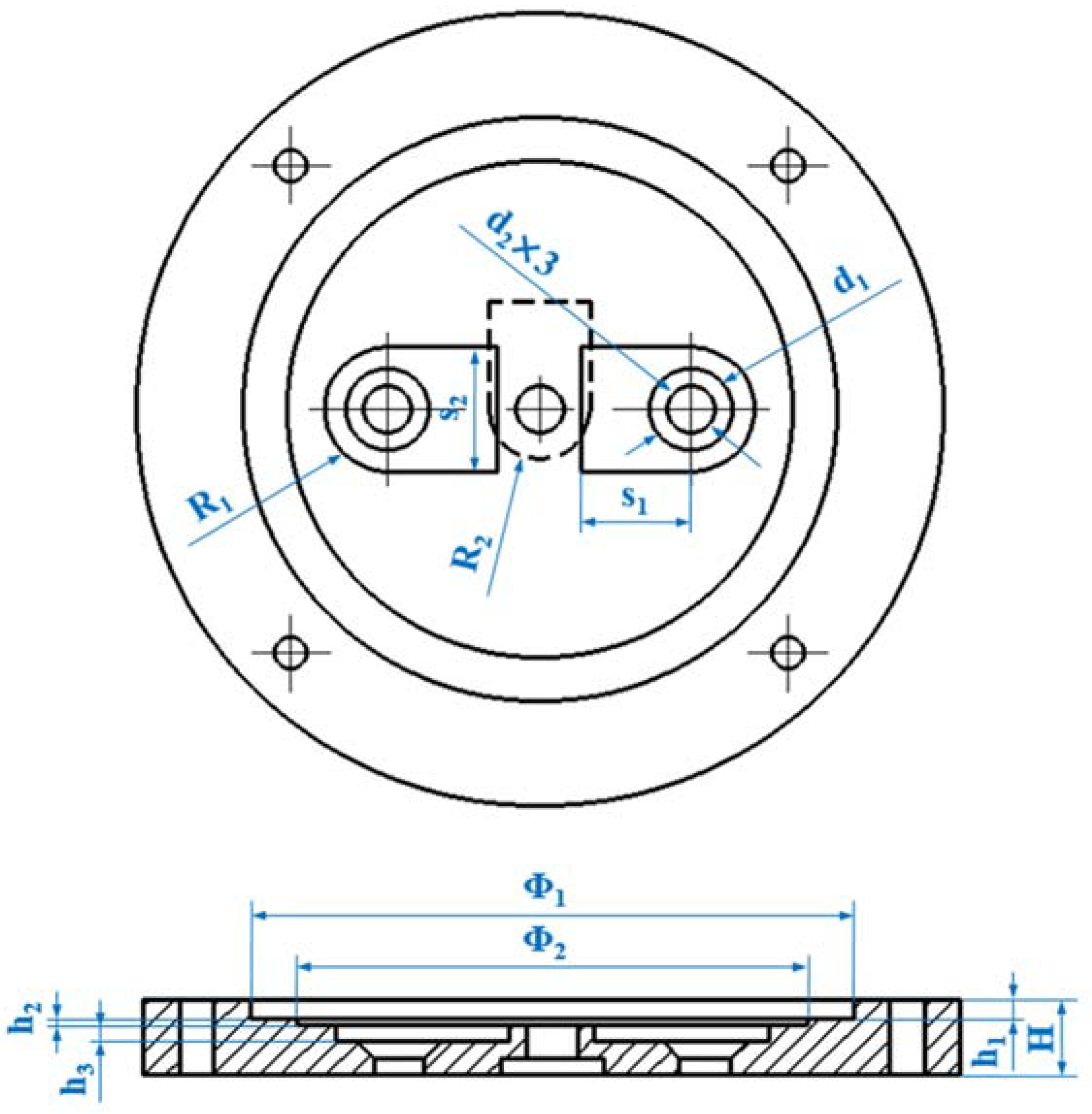


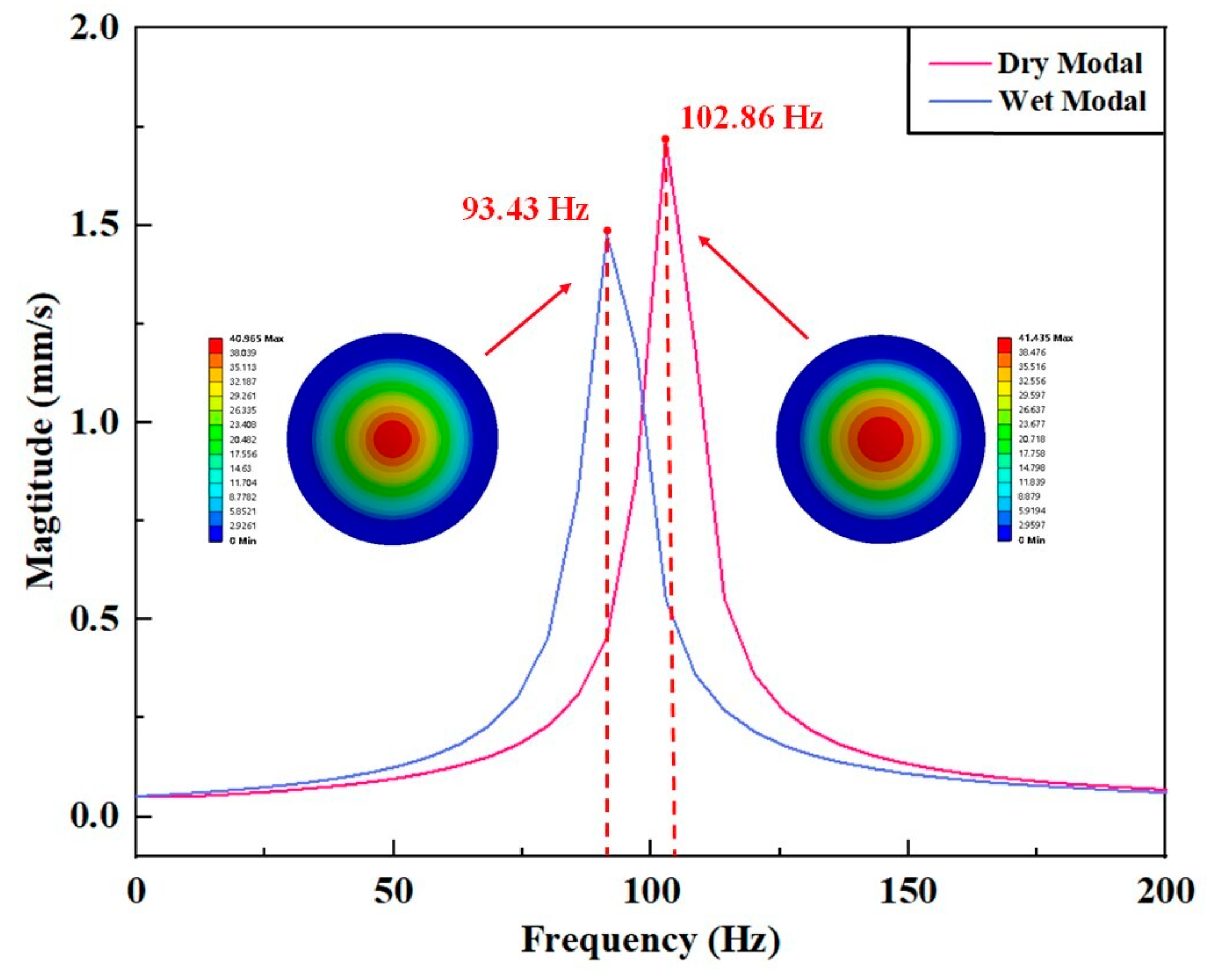

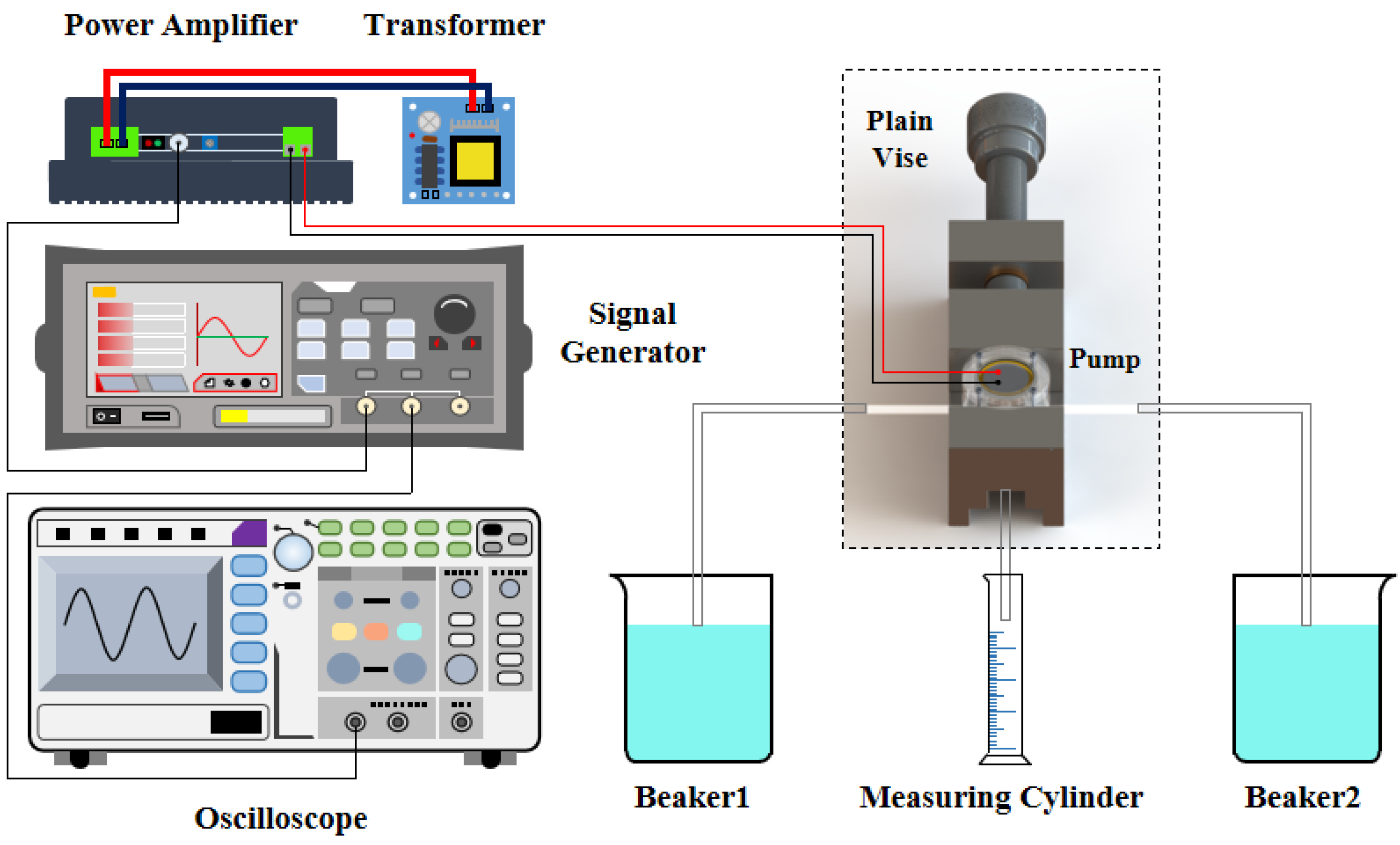
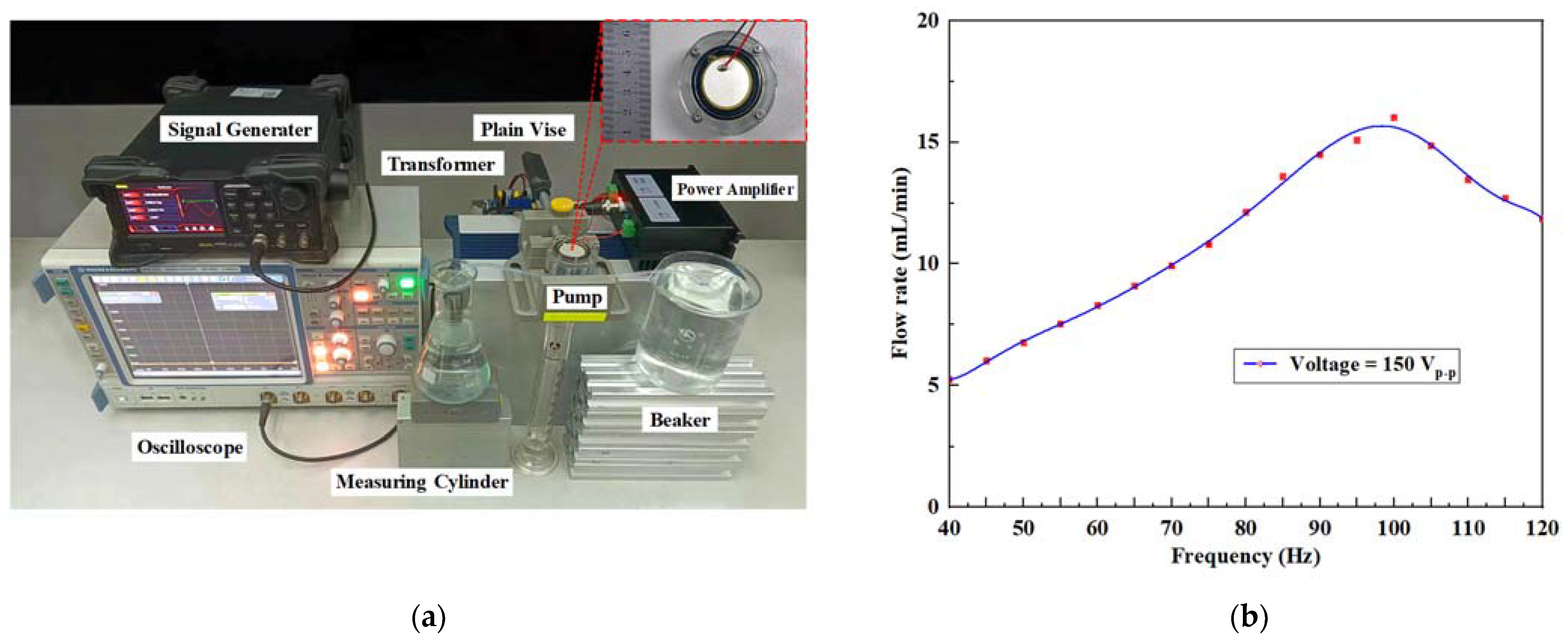

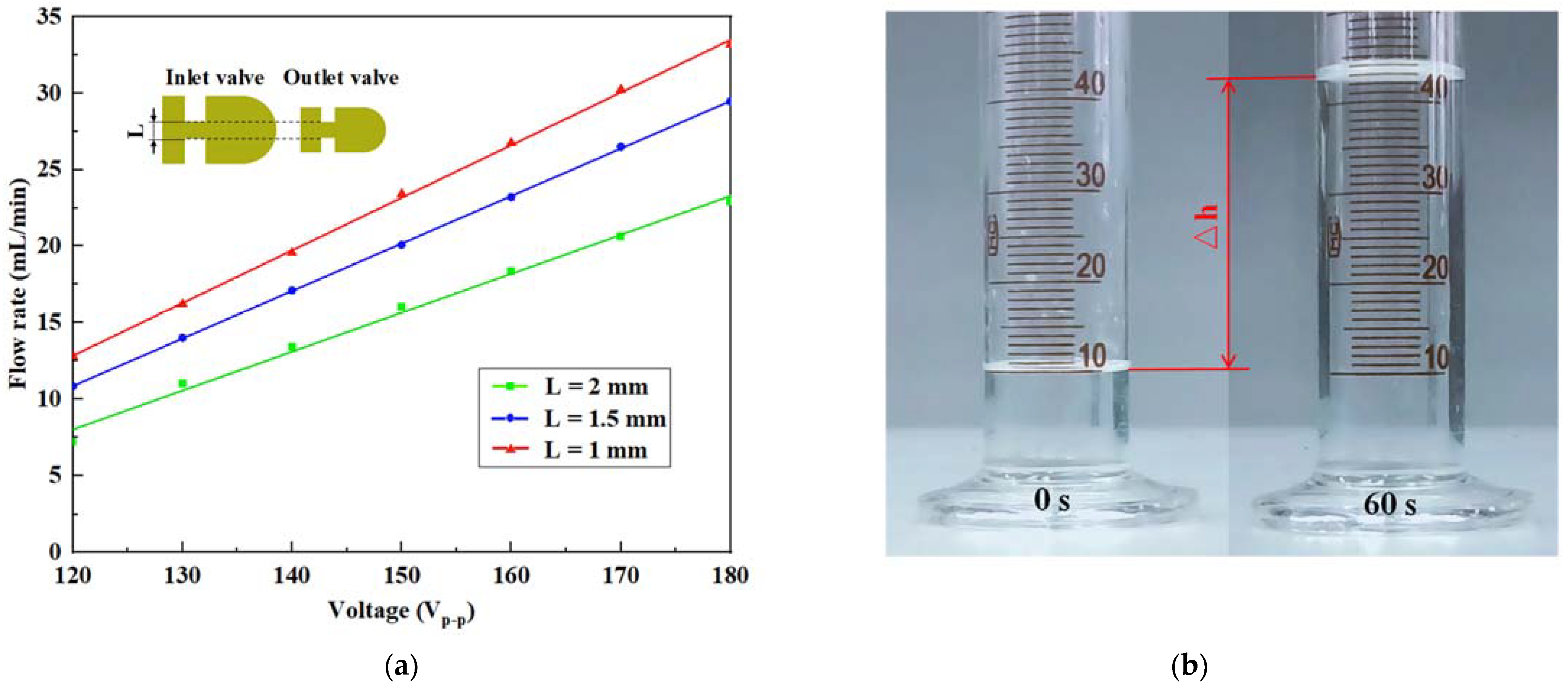
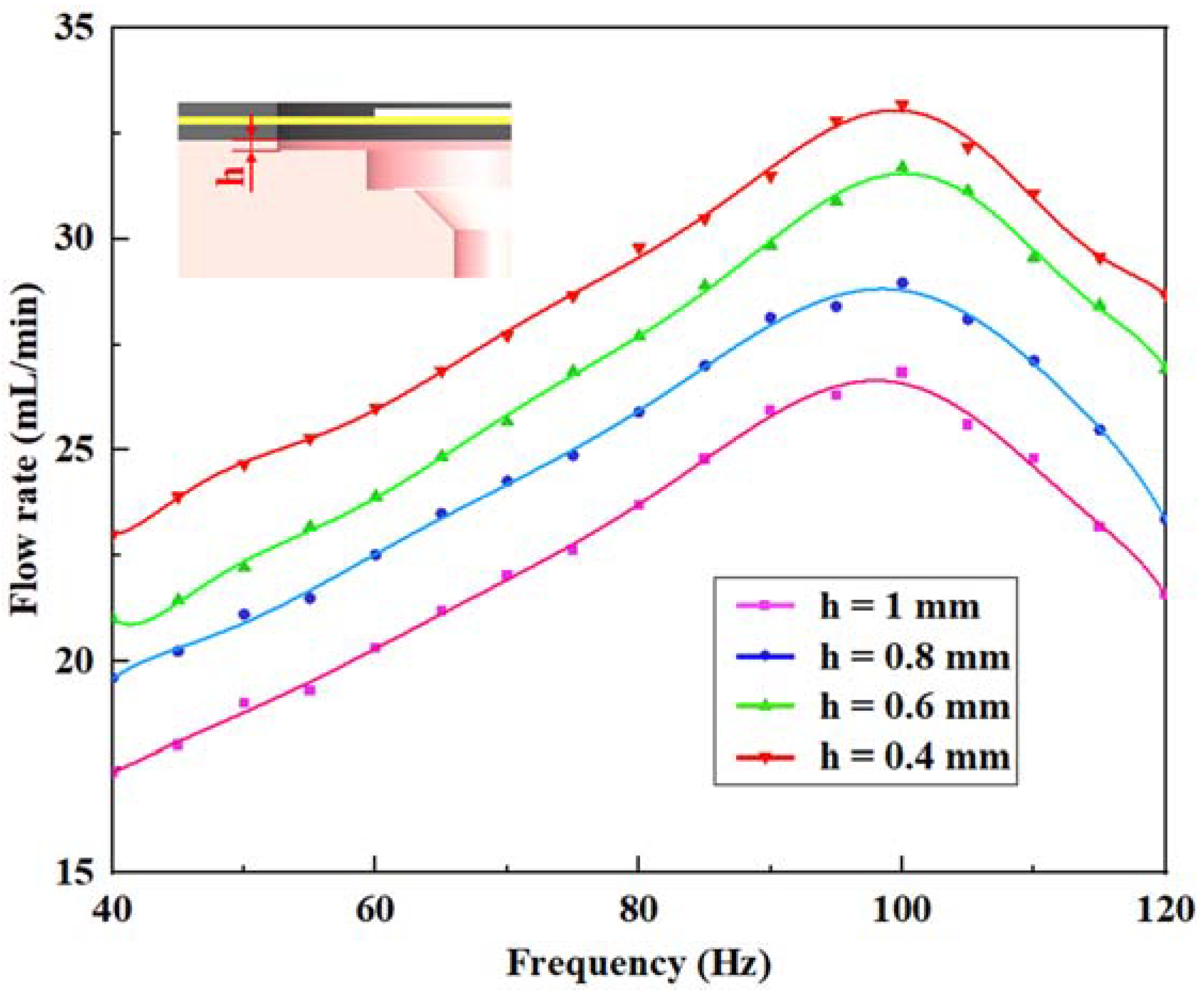
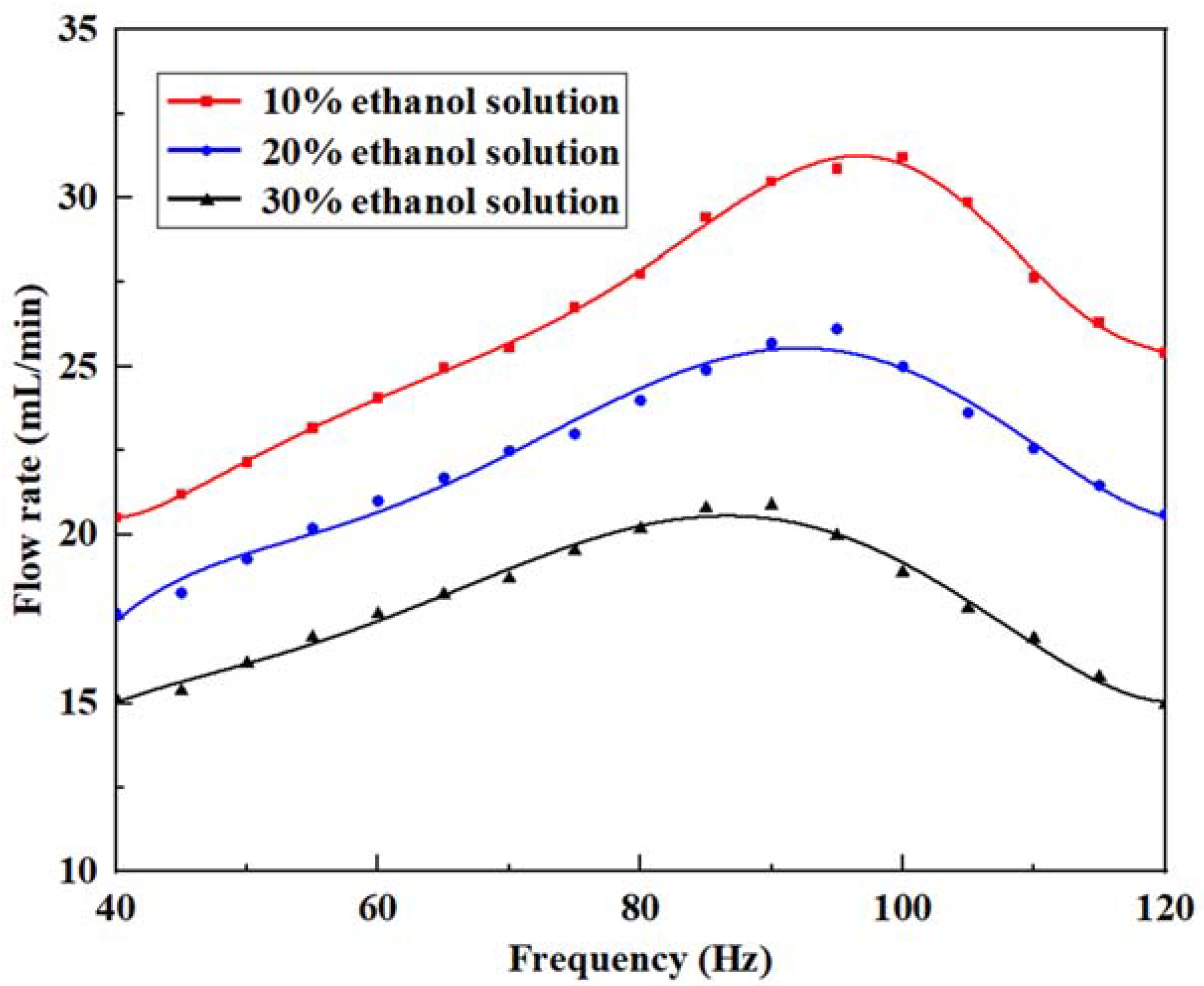
| Parameter | R1 | R2 | d1 | d2 | Φ1 | Φ2 | H | h1 | h2 | h3 | s1 | s2 |
|---|---|---|---|---|---|---|---|---|---|---|---|---|
| Value | 45 | 25 | 5 | 3 | 35 | 30 | 4.5 | 1.2 | 0.1 | 0.8 | 6.5 | 5.5 |
| Material Properties | PZT-5H | Brass | Water | ||
|---|---|---|---|---|---|
| Density (kg/m3) | 7500 | 8800 | 1000 | ||
| Poisson’s ratio | 0.31 | 0.324 | x | ||
| Elastic modulus (×1010 N/m2) | x | x | |||
| Piezoelectric constant (C/m2) | x | x | |||
| Speed of sound (m/s) | x | x | 1482.1 | ||
Disclaimer/Publisher’s Note: The statements, opinions and data contained in all publications are solely those of the individual author(s) and contributor(s) and not of MDPI and/or the editor(s). MDPI and/or the editor(s) disclaim responsibility for any injury to people or property resulting from any ideas, methods, instructions or products referred to in the content. |
© 2023 by the authors. Licensee MDPI, Basel, Switzerland. This article is an open access article distributed under the terms and conditions of the Creative Commons Attribution (CC BY) license (https://creativecommons.org/licenses/by/4.0/).
Share and Cite
Wang, L.; Liu, J.; Wang, X.; Chen, S. A Dual-Inlet Pump with a Simple Valves System. Micromachines 2023, 14, 1733. https://doi.org/10.3390/mi14091733
Wang L, Liu J, Wang X, Chen S. A Dual-Inlet Pump with a Simple Valves System. Micromachines. 2023; 14(9):1733. https://doi.org/10.3390/mi14091733
Chicago/Turabian StyleWang, Le, Junming Liu, Xin Wang, and Si Chen. 2023. "A Dual-Inlet Pump with a Simple Valves System" Micromachines 14, no. 9: 1733. https://doi.org/10.3390/mi14091733




